Table of Contents
How to Get Kids to Clean Up After Themselves
Do you sometimes feel like more of a maid than a mom? Although it’s typically easier to clean up your children’s mess yourself, it’s very important that your child learns the responsibility of cleaning up their toys. But how do you get your kids to clean up their messes without needing to raise your voice or threatening to take away their toys? Clean up time doesn’t have to be a struggle and it can actually be fun! Here are some things you can do to make clean up time go smoothly and even be enjoyable for your kids.
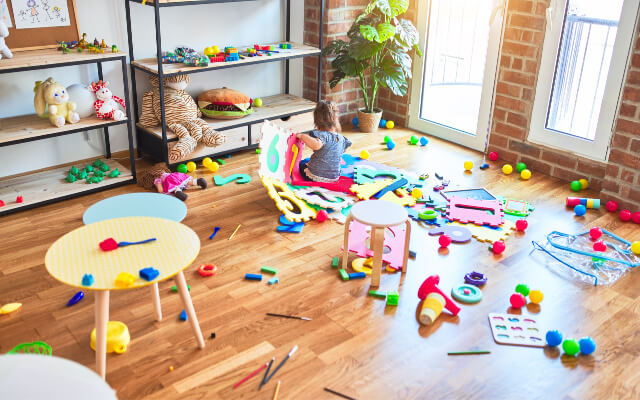
1. Make Rules and Expectations and Be Consistent
It’s important to start by deciding on a set of rules and expectations for how you want your kids to be cleaning up. Be consistent and patient. You will have to repeat these rules and expectations often until it becomes a new habit for your children. The younger they are, the more times you will have to tell them. Here are 3 examples of rules I use.
Toy Free Zones
No matter how clean your house starts, it’s inevitable that kids’ toys end up left in every room of your house by the end of the day. Try instituting toy-free zones in your house. I tried this and it made a big difference in containing the mess.
The toy-free zones in our house are the kitchen, bathrooms, and the master bedroom. You can decide what your rules are for these zones. Our rules are that my daughter is not allowed to bring toys into these areas.
Instituting this rule has made a huge difference in the number of toys that are lying around at the end of the day. This helps our house not look so cluttered and it also makes it easier for my daughter to quickly clean up her toys at the end of the day.
One Toy at a Time
Another rule that makes a big difference is to only allow one toy at a time. If your child wants to play with something else, then they have to put the one they are playing with away first. This is a great rule but one that will take time for your child to develop as a habit.
It is natural for most children to leave their toys out when they want to play with something else. Be persistent, it will pay off when the “get a new toy out/put a toy away” rule becomes a habit for your child.
“A Place For Everything and Everything in Its Place”
Some of the biggest messes at my house have happened when my daughter “put her toys away” but she put them in the wrong spot. Toys weren’t scattered around the house, so I just assumed that everything was cleaned up, and as far as my daughter was concerned, she had cleaned up. But when I got a closer look, her baskets were mixed with puzzle pieces, crayons, stuffed animals, random legos, etc. This took so much more time to clean up than if it had been cleaned up right the first time.
As I already said, cleaning doesn’t come naturally to children. It is a skill to be taught. That’s why it’s important to teach your kids that when they put their toys away, they need to put it where it goes so they can find it next time. This is something that will need to be modeled to your child several times before they will be able to successfully do it on their own.
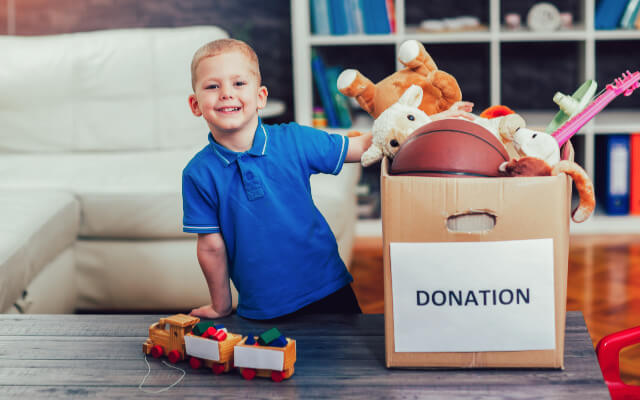
2. Teach Them How to Declutter
If you want your child to keep their room clean, you have to limit the amount of stuff they have. When your child has too many toys, cleaning up becomes even more overwhelming. Even playing becomes overwhelming when they have too many toys because too many toys means too many choices.
My daughter used to have way too many toys. After we decluttered her toys, I was shocked to see how much better she played with the toys that were left. Even though she doesn’t have very many toys now, the toys she does have allow her to play creatively, and she can use them in different ways.
Also, because she has fewer toys, it is easier to keep her toys organized. She can easily find the toy she is looking for without needing to empty everything out of her toy box.
It’s tempting to not involve your child in the decluttering process to avoid the inevitable tears. But it is important to teach your child how to declutter. When they are involved in the decluttering process, they will be more likely to keep their room clean and organized independently later.
Decluttering is something that you will likely do a few times a year. For example, right before or after holidays and birthdays. The more they practice decluttering, the easier it will be.
Declutter Clothes
Clothes are a big problem in most children’s rooms because it is easy to accumulate more clothes than your child needs. When decluttering clothes, get all of your child’s clothes out and sort them into like items. For example, shorts, pants, jeans, short sleeve shirts, long sleeve shirts, dresses, pajamas, etc.
Get four boxes or create four piles and designate categories for each one such as keep, donate, sell, and storage.
Start with one group of like items and sort the clothes into the boxes/piles. Get rid of anything that doesn’t fit, that is stained, or that your child doesn’t ever wear. Continue sorting through each group of items.
Store items that you may want to hand down to another child. Also, depending on the size of your child’s closet, you may want to store seasonal clothes.
Declutter Toys
Get out all toys and start sorting them into like groups. Throw away any broken toys and help your child understand how to get rid of toys that they don’t play with anymore. Only keep the toys that your child actually plays with. If you are unsure whether or not to keep a toy, put it in a “maybe” box. Store the maybe box out of sight. If your child doesn’t ask you about a toy in 3 months, get rid of it.
Keep toys that allow your child to play creatively such as building toys, art materials, and pretend play toys.
I recommend watching a playlist from Minimal Mom about how to declutter and organize kids’ toys for more information.
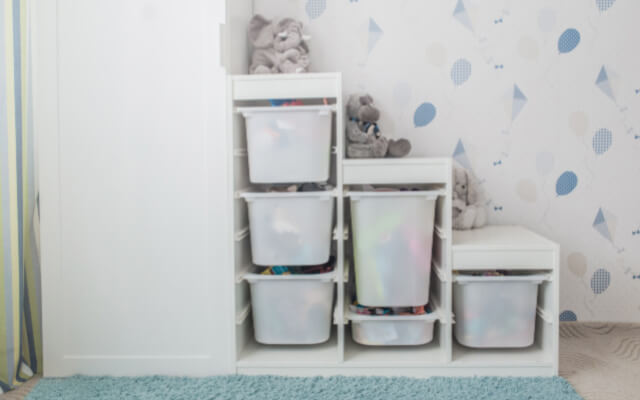
3. Come Up With an Organizational System
Now that your child’s toys and clothes are decluttered, it’s time to come up with an organizational system for what’s left. Involve your children in the process of coming up with an organizational system for their toys. This way, they will take ownership of the system and will be more likely to follow it.
After you are finished decluttering, leave your child’s toys out and sorted into like groups. When the toys are sorted, you will have a better understanding of what type of storage solutions you will need.
Many people make the mistake of buying storage containers before they sort and declutter everything. It’s best to wait to purchase storage containers until you have completed the decluttering and sorting process.
When you have the containers, have your children help you come up with categories for the toys. Put each category of toys in their own basket, bin, or drawer. Now put labels on the baskets, bins, and drawers so your child can easily know where things go. Label with both pictures and words. When every toy has a place, clean up time will be so much easier.
When you are done organizing, make sure that you have done the following:
- Make sure everything has a specific place.
- Make sure bins and drawers are labeled with words and pictures.
- Make sure your child’s toys are divided into specific zones; for example, a reading area, an art area, a pretend play area, a building area. When your child’s toys are in specific areas, it makes it much easier to put things away.
- Make sure clothes are stored in a kid-friendly way so your children can put easily find clothes and put away their own clothes.
- Use drawer dividers and containers to keep drawers organized.
4. Be Specific- Kids are Not Natural Cleaners
If you do end up with a big mess of toys to clean up, be specific with what you want your children to do during clean up time. Try not to give vague directions like“clean up.” If there is a big mess, your child will likely be overwhelmed and won’t know where to start.
Children need to be taught the process of cleaning up. Be specific and break it down into smaller tasks like putting all of the dolls and stuffed animals in the box, and then putting all the books on the shelf, etc. These smaller tasks will seem more manageable to your child and before they know it, the room will be clean.
5. Make Sure Kids Understand Why We Need to Clean
If you asked a kid why they need to clean up their toys, most will tell you, “Because my mom and dad told me to.” They need to understand the real reasons whey they should clean up their messes.
Here are three examples of reasons:
- They should understand that when their room is clean, they know where everything is and they can easily find what they need.
- A clean bedroom is more fun to play in because they have more space to play and they can think more clearly.
- Also, when kids keep their room clean and organized, they never will have big messes to clean up because they are cleaning as they go.
6. Make it Fun
Clean up time doesn’t have to be boring! Use your imagination to turn it into a fun game, mission, or challenge. You can do the classic cleaning races or race the timer games. You can dance to fast-paced music when you clean. I have a list of 21 fun cleaning games for kids that you can get more ideas from.
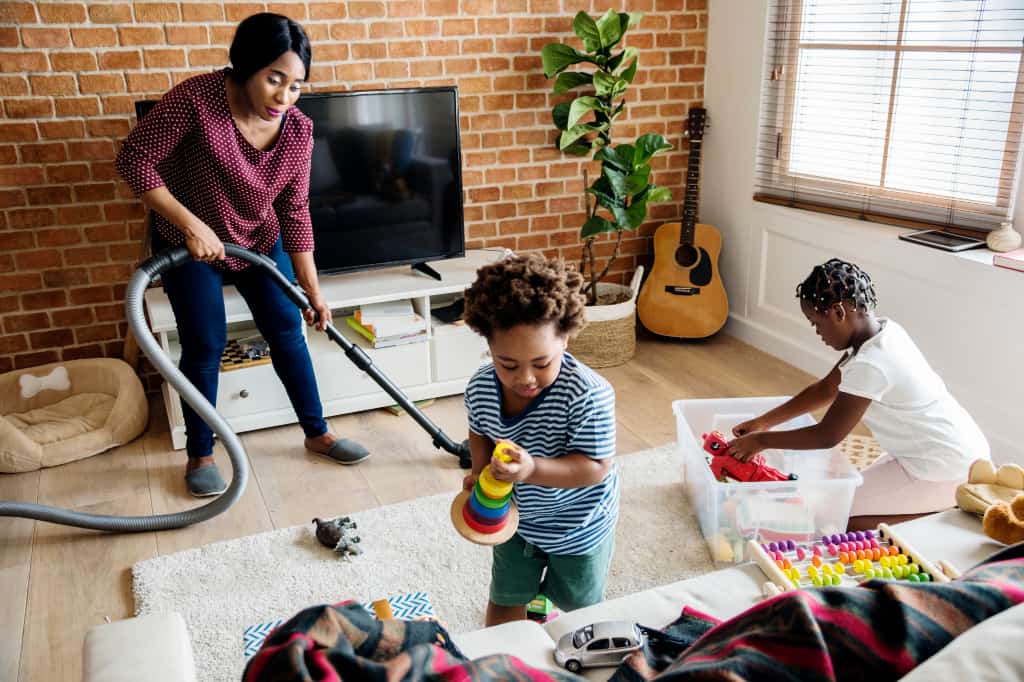
7. Lead By Example
One of the best ways for how to get your child to clean their room is to clean with them. Lead by example by participating in cleaning with your kids. If you want them to make their beds every morning, make sure you make your bed too. If you want them to make sure everything is put back in its space, then you should model that by keeping your things organized.
It’s also important to have a positive mindset about cleaning. Don’t complain about cleaning or tidying up, as this will teach your child to have a bad attitude about cleaning.
Likewise, it is important to clean alongside your child. You can help them clean their space or simply do your own cleaning task while they are cleaning their room and their toys. You can even involve them in helping you with household chores. Regardless, it helps children to see that you are working as a team to get the job done.
8. Have Clear Consequences
Are your children still having trouble keeping their things cleaned up? Consequences may be needed. A method I have used in the past is to collect all toys that are not put away in a trash bag or bin. In order for them to earn those items back they need to keep things cleaned up. If they don’t earn them back, give them away, donate them, or put them in the garage sale box.
This method has been very effective for my daughter. I have only had to donate a few of her toys on two separate occasions. You can pick the time frame that their toys will need to stay away, or how strict you will be about their toys. Whatever you choose, stick to it, and be sure to follow through. Otherwise, your child won’t take you seriously.
9. Recognize Their Efforts
Be sure to give your child praise for being helpful. Make comments about how clean their room is and how nice it is to have their toys sorted in the right baskets. Point out how responsible they are. You can also occasionally give them rewards like treats, stickers, prizes, or money, but be careful. It’s best for kids to be intrinsically motivated. You don’t want them to expect a reward every time they clean their room.
10. Develop Habits and Routines
As I said earlier in this post, cleaning does not come naturally to children. They need clear expectations and need to be taught routines and processes. They need to be taught how to organize and how to avoid big messes in the first place. Continue working with your child until the routine of cleaning up becomes an established habit. For more information on how to help your child develop good tidiness habits, check out the How She Moms Podcast episode 13, How She Teaches Kids to Be Tidy.
Conclusion
Getting kids to clean up after themselves independently is a process, and it involves a lot of coaching and guidance from you. But if you follow these key steps:
- establishing clear rules and expectations
- teaching your child how to declutter and organize
- showing your child specifically how to clean
- helping your child to develop tidiness habits and routines
The results will be well worth all the hard work!
Pin For Later
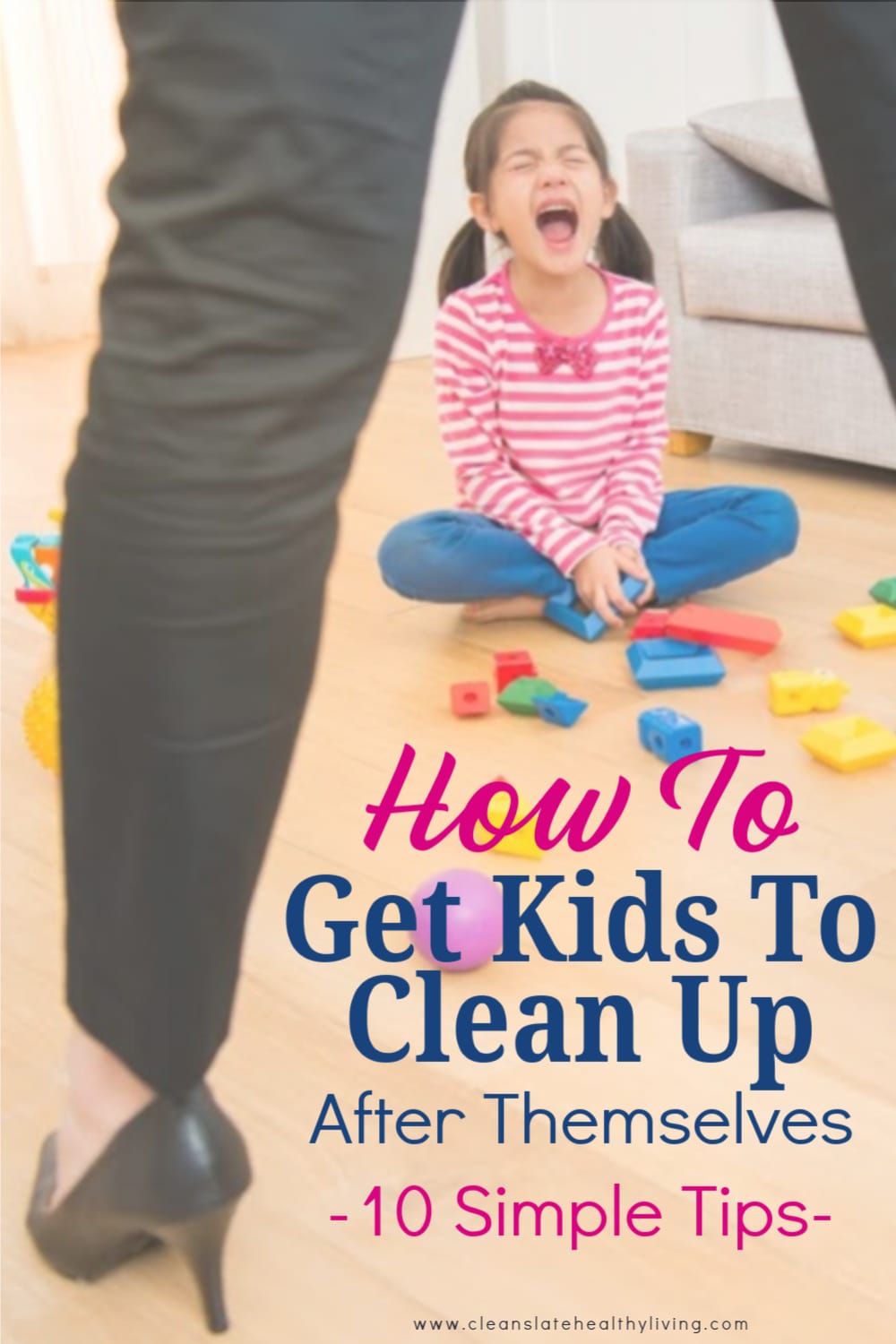

Leave a Reply